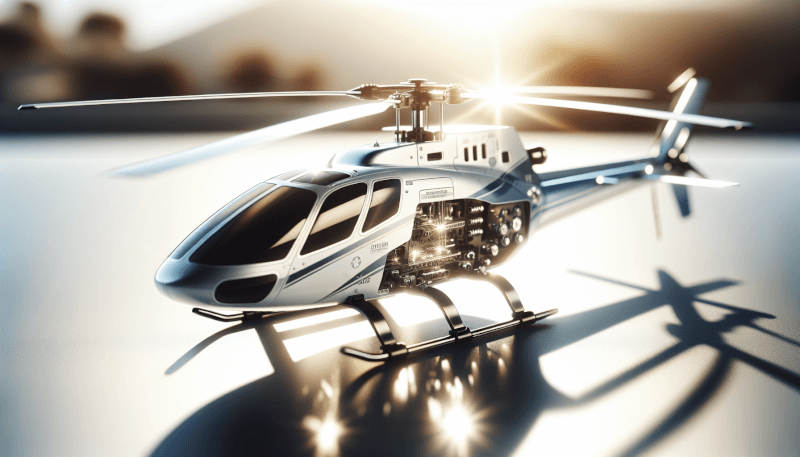Are you a proud owner of an RC Heli? If so, then you already know the joy and excitement that comes with piloting these high-flying machines. To ensure that your RC Heli continues to soar through the sky effortlessly, it’s important to perform regular maintenance. In this article, we will guide you through the essential steps to keep your RC Heli in pristine condition. From inspecting the blades to cleaning the motor, these maintenance tips will not only prolong the lifespan of your RC Heli but also enhance its performance. So buckle up, and let’s dive into the world of RC Heli maintenance!

Regular Maintenance
Regular maintenance is crucial to keep your RC heli in optimal condition and ensure a smooth and safe flight experience. By regularly inspecting and cleaning your heli, checking the battery, examining the rotors, lubricating moving parts, maintaining the motors, verifying electronics, adjusting controls, and performing testing and calibration, you can extend the lifespan of your heli and enjoy uninterrupted fun. Let’s dive into each aspect of maintenance and learn how to keep your RC heli in top-notch shape.
Inspecting the Heli for Damage
Before delving into the maintenance tasks, it’s essential to inspect your RC heli for any signs of damage. Look for cracks, dents, or any other visible damage on the body, rotor blades, landing gear, and other components. If you spot any issues, address them before proceeding with the maintenance tasks. This way, you can ensure the structural integrity of your heli and maintain its overall performance.
Cleaning the Heli
Cleaning your RC heli regularly not only keeps it looking sparkling clean but also helps in maintaining its functionality. Here are the steps to effectively clean your heli:
Removing Dust and Debris
Using a soft brush or canned air, carefully remove any dust or debris that may have accumulated on your heli. Pay attention to the hard-to-reach areas and gently blow away the particles without applying excessive force. This step helps prevent any unwanted interference during flight and enhances the overall performance of your heli.
Cleaning the Body
To clean the body of your heli, use a mild detergent or soap mixed with warm water. Dip a soft cloth or sponge into the soapy solution and gently wipe down the surface of your heli. Pay attention to any stubborn dirt or grime and gently scrub if needed. Avoid using abrasive materials or harsh chemicals that may damage the paint or plastic components of your heli.
Cleaning the Rotors
The rotors play a vital role in the flight of your RC heli, so it’s crucial to keep them clean and free from any dirt or debris. Use a soft brush or cotton swab to remove any dust or debris that may have accumulated on the rotor blades. Take extra care while cleaning the blades, as they are delicate and can easily be damaged. Make sure the rotors are completely clean and free from any obstructions before moving on to the next maintenance task.
Cleaning the Electronics
The electronics components of your RC heli, such as the receiver and gyro, also require regular cleaning. Use a clean, dry cloth or brush to gently wipe away any dirt or dust from these components. Be cautious not to apply excessive pressure or get any moisture into the sensitive electronics. Regularly cleaning these electronic parts ensures their optimal functionality and prevents any potential issues during flight.
Checking the Battery
The battery is a crucial component of your RC heli, and it’s essential to regularly check its condition to ensure a reliable power source. Here’s how you can effectively check the battery:
Inspecting the Battery Exterior
Examine the battery for any signs of physical damage, such as bulging, cracks, or leakage. If you notice any abnormalities, it’s crucial to replace the battery immediately. Damaged batteries can pose safety risks and may result in poor performance or even accidents during flight.
Testing Battery Voltage
Using a battery checker or a multimeter set to the appropriate voltage range, measure the voltage of your RC heli battery. Compare the voltage reading with the manufacturer’s specifications to ensure it falls within the acceptable range. If the voltage is significantly lower than expected, it may indicate a worn-out or low capacity battery that should be replaced.
Charging the Battery
Properly charging your RC heli battery is essential for its longevity and optimal performance. Follow the manufacturer’s instructions provided with your charger to ensure you charge the battery correctly. Avoid overcharging the battery, as it can reduce its lifespan or even cause damage. Use a reliable charger and monitor the charging process closely to ensure a safe and efficient charge.
Replacing the Battery
If your battery fails any of the above tests, it’s essential to replace it promptly. A worn-out or defective battery can significantly impact your flight performance and potentially lead to accidents. Invest in high-quality replacement batteries and ensure they are compatible with your RC heli’s specifications. Always follow the manufacturer’s guidelines when replacing your battery to ensure a seamless transition and continued reliability.

Examining the Rotors
The rotors play a key role in the stability and maneuverability of your RC heli, so it’s crucial to regularly inspect and maintain them. Follow these steps to examine your rotors effectively:
Inspecting the Rotor Blades
Carefully inspect each rotor blade for any signs of wear, cracks, or damage. Look for any warping or bending that may affect the balance or performance of the blades. Even minor damage can lead to significant issues during flight, so it’s important to address any problems promptly. Replace any damaged rotor blades with high-quality replacements that match your heli’s specifications.
Checking the Rotor Balance
Proper rotor balance ensures smooth flight and reduces unnecessary stress on other components of your RC heli. To check the rotor balance, install the blades and gently rotate them by hand. Observe if the blades maintain a consistent height, and if they wobble or sag unevenly, it may indicate an imbalance. Use a balancer tool or add small weights as required to achieve proper balance. A balanced rotor provides improved stability and enhances your overall flying experience.
Lubricating the Rotor Bearings
The rotor bearings are crucial for smooth rotation and reduced friction in your RC heli’s rotors. Regular lubrication helps maintain the bearings’ performance and prolong their lifespan. Follow the manufacturer’s recommendations regarding the type of lubricant suitable for your rotor bearings. Apply a small amount of lubricant to each bearing, ensuring it reaches all the necessary areas. Be cautious not to use excessive lubricant, as it may attract dust and debris, leading to potential issues.
Replacing Damaged Rotors
If you notice significant damage or wear on your rotor blades that cannot be repaired, it’s crucial to replace them promptly. Flying with damaged rotors can result in instability, poor flight control, or even complete failure during flight. Invest in high-quality replacement rotors that match your heli’s specifications and ensure they are securely installed. Regularly inspecting and replacing damaged rotors helps maintain the safety and longevity of your RC heli.
Lubricating Moving Parts
To ensure smooth operation and minimize wear and tear, it’s important to lubricate the critical moving parts of your RC heli. Here’s how you can effectively lubricate these components:
Identifying Critical Moving Parts
Inspect your heli and identify the critical moving parts that require lubrication. These may include gears, shafts, hinges, or any other components that undergo frequent movement. Refer to your heli’s instruction manual or seek guidance from the manufacturer if you are unsure about the specific parts that require lubrication.
Choosing the Right Lubricant
Selecting the appropriate lubricant is crucial to ensure the longevity and optimal functioning of your heli’s moving parts. Different parts may require different types of lubricants, such as silicone-based or lithium-based lubricants. Consult the manufacturer’s recommendations or seek advice from knowledgeable RC enthusiasts to choose the right lubricant for each component.
Applying Lubricant Correctly
Once you have identified the critical moving parts and chosen the suitable lubricant, carefully apply a small amount of lubricant to each part. Ensure that the lubricant is evenly distributed and reaches all necessary areas. Avoid over-lubrication, as excessive lubricant can attract dirt and debris, causing potential issues. Regularly inspect and reapply lubricant as needed to maintain the smooth operation of your heli’s moving parts.

Maintaining the Motors
The motors are the powerhouse of your RC heli, and proper maintenance is essential to ensure their longevity and optimal performance. Here’s how you can effectively maintain the motors:
Inspecting the Motor Housing
Regularly inspect the motor housing for any signs of damage, loose screws, or any other issues. Ensure that the motor’s mounting screws are securely tightened and there are no obstructions that may hinder its operation. Address any problems immediately to prevent further damage and ensure the efficient functioning of your motor.
Cleaning the Motor
Over time, dirt and debris can accumulate in the motor, affecting its performance. Use a soft brush or canned air to remove any dust or dirt particles from the motor. Be cautious not to apply excessive force or damage any delicate components. Cleaning the motor helps prevent overheating and ensures smooth operation during flight.
Lubricating the Motor Bearings
The motor bearings play a crucial role in reducing friction and ensuring the smooth rotation of the motor’s internal components. Regular lubrication helps maintain the bearings’ performance and prolong their lifespan. Refer to the manufacturer’s recommendations for the appropriate lubricant and apply a small amount to each bearing. Be cautious not to use excessive lubricant, as it may attract dust and debris, leading to potential issues.
Replacing Faulty Motors
If your motor exhibits any signs of significant wear, damage, or malfunctions, it’s essential to replace it promptly. Faulty motors can lead to poor performance, overheating, or even complete motor failure during flight. Invest in high-quality replacement motors that match your heli’s specifications and ensure they are securely installed. Regularly inspecting and replacing faulty motors helps maintain the reliability and safety of your RC heli.
Verifying Electronics
The electronics components of your RC heli, such as the wiring, receiver, and gyro, are integral to its operation. Regularly verifying and maintaining these electronic parts is crucial for a seamless flying experience. Here’s how you can effectively verify the electronics:
Inspecting the Wiring
Carefully inspect the wiring of your RC heli for any signs of wear, fraying, loose connections, or other issues. Ensure that all wires are securely connected and properly insulated. Address any problems immediately to prevent potential electrical issues during flight.
Checking for Loose Connections
Gently check all the connections between the electronics components, such as the receiver, gyro, and servos. Ensure that the connections are tight and secure. Loose connections can lead to intermittent signal loss or erratic behavior, impacting the stability and control of your heli. Reconnect any loose connections and verify that they remain secure.
Testing the Receiver
The receiver is responsible for receiving and processing signals from your transmitter, translating them into actions for your heli. Regularly test the receiver to ensure it is functioning correctly. Follow the manufacturer’s instructions for testing the receiver and addressing any issues that may arise. Properly functioning receivers are essential for reliable and precise control during flight.
Calibrating the Gyro
The gyro helps stabilize your RC heli and assists in maintaining its orientation and flight stability. Regular calibration is crucial for accurate gyro operation. Follow the manufacturer’s instructions for calibrating the gyro and ensure that it is properly set up. Calibrated gyros provide improved stability and control, enhancing your overall flying experience.

Adjusting the Controls
Properly adjusted controls are essential for precise and responsive flight control of your RC heli. Here’s how you can effectively adjust the controls:
Checking Control Linkages
Inspect the control linkages of your RC heli to ensure they are properly connected and adjusted. Verify that there is no excessive play or binding in the linkages. Adjust the linkages as necessary to achieve smooth and precise control response. Properly adjusted control linkages are crucial for optimal maneuverability and flight control.
Calibrating the Servos
The servos are responsible for translating your control inputs into mechanical movements of your heli’s control surfaces. Regular calibration ensures accurate and consistent servo operation. Follow the manufacturer’s instructions for calibrating the servos and perform the necessary adjustments. Calibrated servos provide precise response and enhance the overall control of your RC heli.
Adjusting Trim Settings
Trim settings allow you to fine-tune your heli’s control surfaces to achieve optimal flight characteristics and stability. Regularly check the trim settings and make any necessary adjustments to achieve a level and stable flight. Take into account any changes in wind conditions or other factors that may affect your heli’s trim settings.
Fine-Tuning Flight Controls
Regularly test and fine-tune your heli’s flight controls to ensure they are responsive and provide the desired flight characteristics. Experiment with different control settings to find the optimal configuration for your flying style. Fine-tuned flight controls enhance your control precision and maximize the enjoyment of flying your RC heli.
Testing and Calibration
Regular testing and calibration are crucial to ensure the reliable operation and optimal performance of your RC heli. Here’s how you can effectively perform these tasks:
Performing Ground Tests
Before each flight, perform ground tests to verify that all systems are functioning correctly. Test each control input, observe the response, and ensure that all movements are smooth and precise. Perform the necessary adjustments or fixes if any issues are identified during the ground tests.
Verifying Proper Operation
Regularly assess the overall operation of your RC heli and verify that it meets your expectations in terms of stability, maneuverability, and control responsiveness. If you notice any significant deviations from the desired performance, address the issue promptly and perform the necessary maintenance or adjustments to restore optimal operation.
Calibrating the Flight Controller
If your RC heli is equipped with a flight controller, regular calibration is essential for accurate flight control. Consult the manufacturer’s instructions for calibrating the flight controller and follow the recommended procedures. Properly calibrated flight controllers provide improved stability, responsiveness, and flight control precision.
Performing Test Flights
Performing test flights is an essential part of ensuring the proper functioning and performance of your RC heli. Conduct test flights in a safe and open area, carefully observing the flight characteristics and response of your heli. Verify that all controls are responsive, the heli is stable, and there are no abnormal vibrations or noises. Test flights allow you to assess the effectiveness of your maintenance efforts and make any necessary adjustments or refinements.

Proper Storage
Properly storing your RC heli when not in use helps maintain its condition and prolong its lifespan. Here are some essential tips for proper storage:
Cleaning Before Storage
Before storing your RC heli, ensure it is thoroughly cleaned to remove any dust, dirt, or debris that may have accumulated during flights. Use a soft brush or cloth to gently wipe down the body, rotor blades, and other components. Cleaning before storage helps prevent the build-up of grime and ensures a fresh start for your next flying session.
Disconnecting the Battery
To prevent battery discharge or potential damage, disconnect the battery from your RC heli during storage. Ensure the battery is properly charged before disconnecting and store it separately in a cool and dry place. Disconnecting the battery helps preserve its lifespan and prevents any potential electrical issues.
Protecting the Heli
Invest in a suitable storage case or bag to protect your RC heli from dust, moisture, and physical damage. Ensure the heli is securely stored and protected against accidental falls or impacts. Properly protecting your heli during storage helps maintain its integrity and extends its lifespan.
Storage Tips and Tricks
Avoid storing your RC heli in extreme temperature conditions or areas with high humidity. Store it in a cool and dry location, away from direct sunlight or damp areas. Remove any accessories or removable components, such as landing gear or antennas, to avoid any potential damage during storage. Regularly inspect and maintain your storage area to ensure it remains suitable for storing your RC heli.
By following these comprehensive maintenance guidelines, you can keep your RC heli in excellent condition and enjoy countless hours of thrilling flying experiences. Regular inspection, cleaning, battery checks, rotor examination, lubrication, motor maintenance, electronics verification, control adjustments, testing, calibration, and proper storage are all essential components of maintaining your RC heli. Prioritize safety, invest time in maintenance, and reap the rewards of a well-maintained and high-performing RC helicopter.


